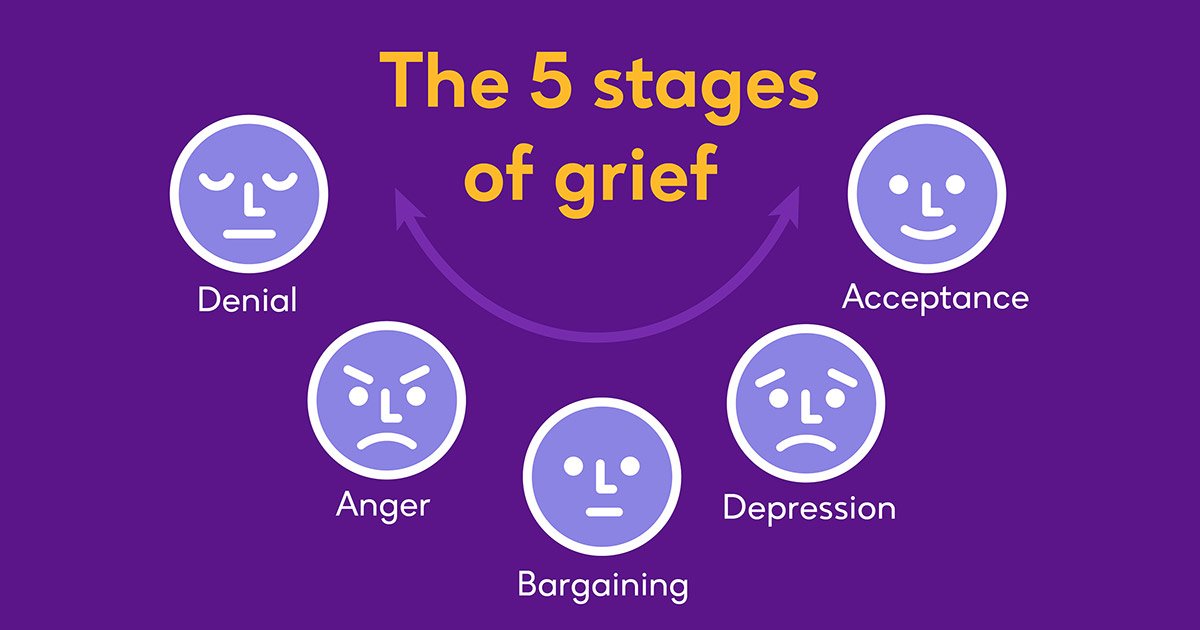Introduction
Grief can feel heavy, confusing, and lonely. It can also feel different each day. You might wake up okay, and then a memory hits hard. You might wonder if you are “doing it right.” You are not broken. You are human. This guide explains The Five Stages of Grief in simple words. It shows what the stages can look like in real life. It offers kind tools you can try today. It also shares ways to support friends, kids, and coworkers. You will learn that grief is not a test. It is a process. It is love trying to find a new path. Take your time. Breathe. You do not have to do this alone. Help is always allowed and always welcome.
What Do We Mean by “The Five Stages of Grief”?
The model comes from Dr. Elisabeth Kübler-Ross. She wrote about people facing death. Over time, the ideas were used for loss and bereavement. The Five Stages of Grief are denial, anger, bargaining, depression, and acceptance. These stages are not rules. They are a map that many people recognize. You may not feel each stage. You may feel several in one day. You may circle back and repeat one. That is normal. Grief is not a straight line. It is a wave that rises and falls. The model gives language for feelings. It helps you notice where you are. It also helps you choose the next small step.
Stage 1: Denial — Why Numbness Shows Up First
Denial is a soft shield. It mutes pain so you can get through the day. Your mind says, “This cannot be real.” You may feel foggy. You may keep busy. You may avoid places or photos. This stage can help you cope when the loss is fresh. It gives your body time to adjust. Denial fades in and out. It can return on anniversaries or holidays. If you feel stuck, try gentle grounding. Name five things you see. Feel your feet on the floor. Drink water. Tell someone you trust, “I feel numb today.” They can sit with you. Using the language of The Five Stages of Grief can make that ask easier.
Stage 2: Anger — Making Room for Hot Feelings
Anger is common in grief. It can aim at people, plans, or fate. You might ask, “Why me?” You might feel cheated or misled. Anger has energy. It protects tender parts of your heart. It can also scare you. Let it move in safe ways. Try a brisk walk. Try a strong cry. Write the hard words in a private journal. Say them out loud in a car. Anger often hides sadness. Notice what sits under the heat. You may find fear, guilt, or deep love. That is okay. Share your feelings with a counselor if they feel too big. Naming anger as part of The Five Stages of Grief can reduce shame.
Stage 3: Bargaining — The Mind Tries to Rewind
Bargaining sounds like “If only.” It tries to make deals with life. “If I do this, can I get them back?” It can also show up as guilt. You replay moments. You search for the one choice that could change the end. This is a normal step. The mind wants control. It looks for meaning and safety. Meet this stage with kindness. You did the best you could with what you knew then. Write a letter to your past self. Thank them for trying so hard. Note what you learned. Hold the truth that love is not a math problem. Bargaining will ease with time. It helps to remember The Five Stages of Grief are not a checklist.
Stage 4: Sadness and Low Mood — When the Weight Sits Still
Many people call this stage depression. In grief, it often means deep sadness. You may feel heavy and slow. You may sleep too much or not at all. Food may lose taste. Joy may feel far away. This stage can be scary, yet it is honest. You are facing the size of your loss. Be gentle with your body. Keep simple routines. Take a shower. Sit in the sun for a few minutes. Eat small, steady meals. Ask a friend to walk with you. Try a support group. If your mood stays very dark, seek a therapist. If you think of hurting yourself, call your local emergency number now. The Five Stages of Grief model reminds you this feeling will shift.
Stage 5: Acceptance — A Different Kind of Okay
Acceptance does not mean you “got over it.” It means you make room for what is true. You carry the love in a new way. You start to build a life that includes the loss. You may notice small moments of peace. You may laugh and not feel guilty. You may honor the person or dream you lost with rituals. Acceptance grows slowly. It comes and goes. You might feel acceptance and sorrow on the same day. That is normal. You can still miss what you lost and make new plans. The Five Stages of Grief close with acceptance because it points toward hope. It shows that healing is possible and real.
The Stages Are Not a Straight Line
You will hear this often because it matters. Grief is messy. It bends and loops. You can move from denial to anger to acceptance in one week. Then sadness may return next month. Memories, songs, smells, and dates can pull you back. This does not mean you failed. It means you are human. Imagine grief like weather. The storm can pass and then return. You learn how to carry an umbrella. You learn where to find shelter. You learn who to call. Keep using the names from The Five Stages of Grief to check in with yourself. Ask, “Where am I today?” Then choose one kind action that fits.
Grief Shows Up in Many Kinds of Loss
We grieve people we love. We also grieve other losses. A breakup can bring mourning. A job loss can shake your identity. Moving can hurt, even when the move is good. Illness can change your body and dreams. Miscarriage and infertility carry deep pain. Pets are family and their loss can be huge. Each loss can move through familiar feelings. Denial, anger, bargaining, sadness, and acceptance can all appear. The mix and the timing may change. The love behind the grief stays real. The Five Stages of Grief help you spot patterns. They also remind you to give your heart time and space to heal.
How to Support Yourself Day by Day
Grief drains energy. Small habits can help steady you. Keep a simple sleep schedule. Drink water through the day. Eat balanced meals, even if small. Move your body for a few minutes. A short walk counts. Try slow breathing. Inhale for four. Exhale for six. Repeat ten times. Sit with your feelings for a set time. Then take a break and do one kind task. Make a “comfort kit.” Add tissues, a soft scarf, a soothing tea, and a kind note. Try a short journal entry each night. Note one hard thing and one small good thing. Use the language of The Five Stages of Grief to track your mood and needs.
How to Support a Friend in Grief
You do not need perfect words. You need a steady presence. Say, “I am here.” Say, “This is so hard.” Do not try to fix the pain. Offer simple help. Drop off a meal. Fold laundry. Drive to an appointment. Put reminders in your phone to check in. Remember key dates like birthdays and anniversaries. Ask open questions. “What feels hardest today?” Listen more than you speak. Do not compare losses. Do not rush their timeline. Respect their pace and their culture. If they want company, sit and watch a show together. If they want quiet, be near without talking. Learning about The Five Stages of Grief can help you show patience.
Simple Tools That Help Many People
Many tools can ease grief. Try writing letters to the person you miss. Tell them about your day. Light a candle at dinner. Keep a memory box with photos and small items. Plant a tree or flowers. Make a playlist that holds your feelings. Talk with a counselor or therapist. Join a support group in your area or online. Explore gentle mindfulness. Pay attention to breath and body. Practice gratitude without forcing it. One tiny bright point counts. Build rituals that fit your faith or tradition. Keep them simple and repeat often. These tools work best with time and care. They fit well with The Five Stages of Grief because they honor each feeling.
Grief in Children and Teens
Kids grieve in bursts. They may cry hard and then go play. They need clear words. Skip phrases like “passed away” if they confuse the child. Simple truth is kind. Answer questions as they come. Keep routines where possible. Offer choices, like which photo to place on a shelf. Teens may pull away. They still need safe adults who check in. Watch for big behavior shifts. Keep the door open for talks. Invite art, music, or sports as outlets. School counselors can help with support. Let kids see healthy tears. Show that feelings are safe. Use the ideas from The Five Stages of Grief to give language they can hold.
Grief at Work and School
Work and school carry pressure. Grief adds a heavy load. Tell a manager, teacher, or advisor what you need. Ask for flexible deadlines where possible. Share the dates that may be hard. Plan short breaks during the day. Use simple coping steps at your desk. Breathe, stretch, and drink water. Keep a small token that comforts you. Ask a trusted coworker or classmate to be a check-in buddy. If you supervise others, set a caring tone. Offer clear options and time off when possible. Respect privacy and culture. Celebrate small wins as energy returns. Naming The Five Stages of Grief at work or school can reduce stigma and invite care.
Culture, Faith, and Ritual Matter
Grief lives inside culture and faith. Traditions offer structure, hope, and belonging. They guide funerals, prayers, songs, and gatherings. They can also shape mourning time and customs. Learn your family’s ways. Ask elders for stories. Let your heart choose what helps most. Some people need community. Some need quiet. Both are valid. Mix old rituals with new ones that feel right. Light a candle. Share a favorite recipe. Donate to a cause they loved. Visit a special place. Keep grace for the choices of others. Using The Five Stages of Grief with cultural care keeps the model human, kind, and flexible.
Milestones, Triggers, and Anniversaries
Dates can sting. Anniversaries, birthdays, and holidays can bring sharp waves. Plan for them ahead of time. Make a simple “day-of” plan. Include rest, comfort food, and one supportive person. Choose a way to honor the memory. Share a story at dinner. Look through photos for a set time. Then take a gentle break. Triggers can pop up at random. A smell, a song, or a street can hit hard. When that happens, pause and breathe. Ground yourself with your senses. Later, write what helped. Build a small menu of go-to steps. The language from The Five Stages of Grief can help you name the wave and ride it.
When to Seek Extra Help
Reach out for help if daily life stays very hard. Watch for signs like constant hopelessness, deep numbness, or thoughts of self harm. Notice if you use alcohol or drugs to cope. Look for big changes in sleep, eating, or energy. A licensed therapist can help you carry the load. A doctor can check on your body’s stress. Support groups offer care from people who understand. If you think you might hurt yourself or someone else, call your local emergency number right now. You deserve safety and care. Getting help is a strong choice, not a failure. Grief is heavy. You do not have to lift it alone.
Real-Life Examples You Can Picture
Picture Sam, who lost a parent. Sam felt denial for weeks. Work kept Sam busy. Then anger hit when bills arrived. Sam wrote letters at night and cried in the car. Over time, the fog lifted. Sam felt moments of peace and a wish to cook Dad’s soup. Now picture Laila after a breakup. She bargained for “one more talk.” Then the sadness settled in. Laila made a memory box and leaned on friends. She later reached acceptance and set new goals. These stories show common paths. They also show that each path is unique. The map of The Five Stages of Grief helps you find your own way.
Myths and What Actually Helps
A big myth says grief ends fast. It does not. It changes shape. Another myth says strong people do not cry. They do. Tears are human and healthy. Some think joy means you forgot. It does not. Joy and sorrow can sit together. Another myth says the stages are strict steps. They are not. They are clues, not commands. What helps is simple and steady care. Rest, food, movement, and kind company help. Honest words help too. Counseling can guide tough stretches. Rituals can hold memories with love. Use the flexible map of The Five Stages of Grief and trust your pace.
Healing, Meaning, and Growth
Healing does not erase love. It helps you carry love forward. Meaning can grow from pain with time and support. You might volunteer for a cause your person loved. You might mentor someone younger. You might start a small tradition that keeps a story alive. Growth is not a race. Do small, kind acts and notice what brings a little light. Share your needs with safe people. Choose rest without guilt. Keep checking in with your body. Healing is many tiny steps repeated. The feelings will still come and go. Over time, the wave can soften. You can hold both grief and hope and keep going.
FAQs About The Five Stages of Grief
1) Are the stages always in order?
No. Many people move through them in different patterns. You can skip a stage. You can repeat one. You can feel two at once. This is normal. The model is a guide, not a rule. It gives names to common feelings. It helps you notice what is happening inside. Some days you may feel calm. Other days you may feel anger or deep sorrow. That does not mean your healing broke. It means healing is active. It shifts as you grow. If you feel stuck, reach out for support. A counselor can help you work with The Five Stages of Grief in a way that fits you.
2) How long does grief last?
There is no set timeline. Grief changes over months and years. The sharp pain tends to ease, but love remains. Anniversaries can bring back strong feelings. That is okay. Healing is not forgetting. It is making space for what happened and what matters now. Give yourself permission to move at your pace. Track sleep, food, and movement to support your body. Share your needs with people you trust. If you feel no change at all for a long time, get extra help. Your heart and body both need care. Time helps, but support and skill help too.
3) Can I grieve a breakup, a job, or a move?
Yes. Grief shows up after many kinds of loss. A breakup can change your daily life and your plans. A job loss can shake your identity and routine. A move can mean leaving friends and familiar places. You may feel denial, anger, bargaining, sadness, and acceptance in new ways. The body reacts to change. Treat these losses with care. Use sleep, food, movement, and support. Build small rituals to say goodbye. Then build new routines to say hello to the next chapter. Your feelings are valid. They deserve the same kindness you would give a friend.
4) How do I tell kids about death or loss?
Use clear and simple words. Say “died” rather than soft terms that confuse. Answer questions with short, honest sentences. Check for understanding. Keep routines as much as you can. Offer choices and small jobs, like choosing a photo to display. Let them see safe tears. It shows that feelings are okay. Expect questions to repeat. Offer art, play, or sports as outlets. Tell teachers or caregivers what is happening. Create a small ritual they can repeat, like a bedtime story or a candle. If behavior changes a lot, seek help from a child counselor. Your calm presence is the strongest support.
5) What if people around me want me to “move on”?
You get to decide your pace. People often mean well but feel awkward with pain. You can set gentle boundaries. Say, “I am not ready for that talk yet.” Say, “Please just listen today.” Seek people who can sit with you without fixing. A support group can help. A therapist can help. You can also plan “grief time” and “rest time.” That way you honor your feelings and protect your energy. Share key dates with close friends so they can show up. Your healing is not a race. It is your path. You do not need permission to take your time.
6) How can I honor a loved one while I heal?
Create simple, repeatable acts of memory. Cook a favorite meal on a special date. Keep a photo in a place that feels good. Visit a meaningful spot. Write letters when you miss them. Share stories with family and friends. Start a small fund or donate to a cause they cared about. Wear a piece of jewelry or a color that reminds you of them. Plant a tree or flowers. Make a playlist of songs you shared. None of these erase pain. They help your love keep moving. They bring softness to hard days. Let these acts grow and change as you do.
Conclusion: You Are Not Alone in This
Grief is love with nowhere to go. Over time, it learns a new home. The map of The Five Stages of Grief can help you notice where you are and choose one kind next step. Keep your supports close. Ask for help when you need it. Build tiny, steady habits that care for your body and your heart. Honor your culture and your story. Share this guide with someone who needs a gentle word. If you want, reply with the stage that shows up most today. I can suggest a few small steps that fit that stage. We can walk this path, one simple breath at a time.









